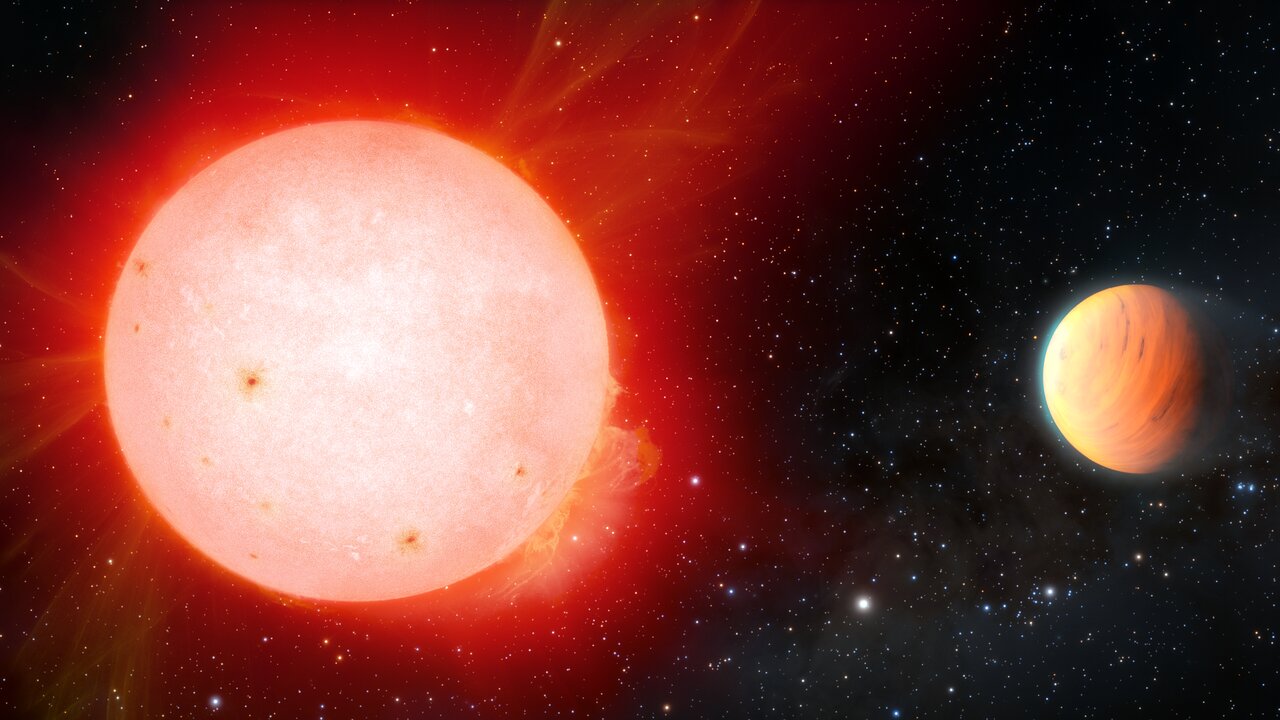'Marshmallow' world defies expectations for planets orbiting red dwarf stars

Astronomers have discovered a gas giant planet with the density of a marshmallow orbiting a cool red dwarf star located 580 light-years from Earth. The Jupiter-like exoplanet is the lowest-density world ever observed orbiting a red dwarf.
Red dwarf stars are the smallest and dimmest stars which are still converting hydrogen to helium in their cores through nuclear fusion, a stage of a star's life that astronomers called the "main sequence." Although much cooler than the sun, red dwarfs are known to be extremely active and launch powerful flares that can strip the atmospheres of any orbiting planet.
These violent eruptions make a red dwarf star system a seemingly unlikely and inhospitable place to find a fluffy exoplanet like the newly discovered world, dubbed TOI-3757 b. The planet is so close to its red dwarf parent star that it completes an orbit in just 3.5 Earth days, 25 times quicker than the closest planet to the sun, Mercury, completes an orbit of our star. It's also just slightly larger than Jupiter, the solar system's largest planet, with a diameter of around 100,000 miles (150,000 kilometers).
"Giant planets around red dwarf stars have traditionally been thought to be hard to form," Shubham Kanodia, study lead author and astronomer at the Carnegie Institution in Washington, D.C., said in a statement from the National Science Foundation's NOIRLab, which operates some of the telescopes used in the research.
Related: 10 amazing exoplanet discoveries
"So far this has only been looked at with small samples from Doppler surveys, which typically have found giant planets further away from these red dwarf stars," he said. "Until now we have not had a large enough sample of planets to find close-in gas planets in a robust manner."
Kanodia and his colleagues think they may be able to explain how a low-density gas giant formed in such unfavorable and extreme conditions. They propose that the low density of TOI-3757 b is the result of two main factors.
Breaking space news, the latest updates on rocket launches, skywatching events and more!
The first factor relates to how gas giants begin their formation, with massive rocky cores around 10 times the mass of Earth, which rapidly pull in large amounts of surrounding gas to become Jupiter-like worlds.
The team thinks that the lower abundances of heavy elements in the red dwarf star that TOI-3757 b orbits means that the rocky core of this particular exoplanet may have formed more slowly. This would have delayed the accretion of gas to the rocky core with an impact on TOI-3757 b's overall density after formation.
Secondly, the astronomers think that the orbit of TOI-3757 b is slightly elliptical, like a flattened circle, so there are times when it is closer to its red dwarf parent star. These closest approaches result in excessive heating of the planet which causes its atmosphere to bloat.
TOI-3757 b was initially discovered by NASA's Transiting Exoplanet Survey Satellite (TESS) mission, which spots exoplanets via the tiny dip in the light of their parent stars they cause as they cross or transit the face of that star. Kanodia and the team then followed up on this initial sighting with a host of ground-based instruments.
TESS observations revealed TOI-3757 b's diameter, while the scientists used instruments at Kitt Peak National Observatory in Arizona and McDonald Observatory in Texas to measure the exoplanet's radial velocity, the speed it travels along the line of sight. From these results, astronomers calculated the planet's mass, at about one-quarter that of Jupiter or about 85 times that of Earth.
Obtaining a diameter and a mass for TOI-3757 b allowed the team to calculate the density of the gas giant as being about 0.6 ounces (17 grams) per cubic foot. This makes TOI-3757 b less than half as dense as Saturn, which is the lowest-density planet in the solar system and is about one-quarter the density of water.
This means that the exoplanet is similar in density to a marshmallow, and if there was a bathtub large enough to fit the gas giant in it, it would float on the water.
The team hope to further investigate this fluffy exoplanet with the James Webb Space Telescope (JWST) to learn more about its strange atmosphere. The researchers will also hunt for similar worlds around red dwarf stars in other systems.
"Finding more such systems with giant planets — which were once theorized to be extremely rare around red dwarfs — is part of our goal to understand how planets form," Kanodia concluded.
The team's research is published in The Astrophysical Journal.
Follow us on Twitter @Spacedotcom and on Facebook.

Robert Lea is a science journalist in the U.K. whose articles have been published in Physics World, New Scientist, Astronomy Magazine, All About Space, Newsweek and ZME Science. He also writes about science communication for Elsevier and the European Journal of Physics. Rob holds a bachelor of science degree in physics and astronomy from the U.K.’s Open University. Follow him on Twitter @sciencef1rst.
